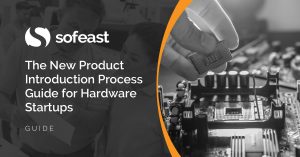 In phase 5.7 of developing a new product once a prototype has been tested, design iterations have taken place, and tooling is ready (if applicable), it is time to test whether quality products can be made at the right speed in the Chinese factory you have selected.
In phase 5.7 of developing a new product once a prototype has been tested, design iterations have taken place, and tooling is ready (if applicable), it is time to test whether quality products can be made at the right speed in the Chinese factory you have selected.
(Don’t forget that you can see the whole series on developing a new product here.)
As you will see, the new product development process we advise follows somewhat the same logic as the AQPQ (Advanced Product Quality Planning Process) used in the car industry.
The Trial Production Run (TPR)
A trial production run takes place to establish whether the existing mass production process is capable of manufacturing your products to the required quality with the agreed production capacity, for a stipulated period, or of providing the relevant services.
The following criteria should apply with supporting data for each element as a result of the TPR:
- all mass production equipment (e. g. installations, machinery, tools, inspection equipment) must be in operation
- using mass production material
- working to full capacity
- using standard personnel
- and all supporting systems
The TPR should be carried out with a batch size which represents the volume that would normally be run, or at least the target volume, for a full shift, eight to twelve hours for example.
One of the best methods of gathering data for analysis during the TPR is for a simple time and motion study. With engineers and production management reviewing each element of each station within the production process, data can be gathered that allows for improvements to be made. This process also provides the opportunity to identify where additional training needs to take place.I
Interested in this topic? You may also like Sofeast’s New Product Launch Roadmap[XLS + Video]
Our ‘new product launch roadmap’ unveils the steps that your supplier will never tell you are needed, and yet all veteran buyers consider as indispensable. Hit the button to get your copy:
Reviewing the data
The TRP data should be reviewed and it should be the quality assurance engineer who leads these reviews but should consist of a cross-functional team wherever possible. These critical, multiple-perspective reviews help ensure the final product built on the production line will meet quality requirements and your expectation. This review is especially beneficial for lines that employ large amounts of manual labor due to the human-oriented quality of the controls (visual inspection).
Monitoring how each operator carries out their tasks and comparing the actions against the work instructions and at the same time monitoring the time it takes to complete each task should provide valuable data that can be used to adjust how operators function, improve work instructions, and increase the overall performance of the production process.
When to Implement TPR
There are clearly times when a trial production run is obviously required. When a new product is being made for the first time, however, there are other less obvious situations which call for a trial production run where the product is produced and everything is monitored and data recorded for analysis and review.
Ideally, the following situations should trigger the TPR process:
- New products being introduced on to a production line that has never built that product before.
- Any major changes made to a current product, including sub-assemblies and critical component supplier changes.
- Any material specification changes — these may be introduced as a cost down initiative; TPR is still required as this is a significant change.
- Production of an existing product stopped for an extended period of time, greater than six months or more (during that time they may have been staff changes and product build knowledge lost).
Implementing a trial production run in a Chinese factory is of the utmost importance if you, as the buyer, don’t want bad surprises. This will give you all the data mentioned above for you to review, analyze and discuss with your supplier about the following topics:
- Product improvements
- Quality improvements
- Potential areas for cost reduction
- The reassurance that they can, in fact, produce your product to the required quality level
I have seen too many importers trust a Chinese manufacturer to make a complex new product right the first time. From experience, in 98% of cases, it just doesn’t happen. There are always surprises — it is up to you to decide whether you want to find them out upfront or after you have wired a deposit and you have a shipping deadline.
Go to part 13: Assembly Review after an Initial Product Build
Want to learn more about the new product introduction process for hardware startups?
Whether you’re some way along the process, or just starting out, Sofeast’s guide covers everything hardware startups need to know for making a new product in China and successfully bringing it to market.
Hit the button below to read the guide:



